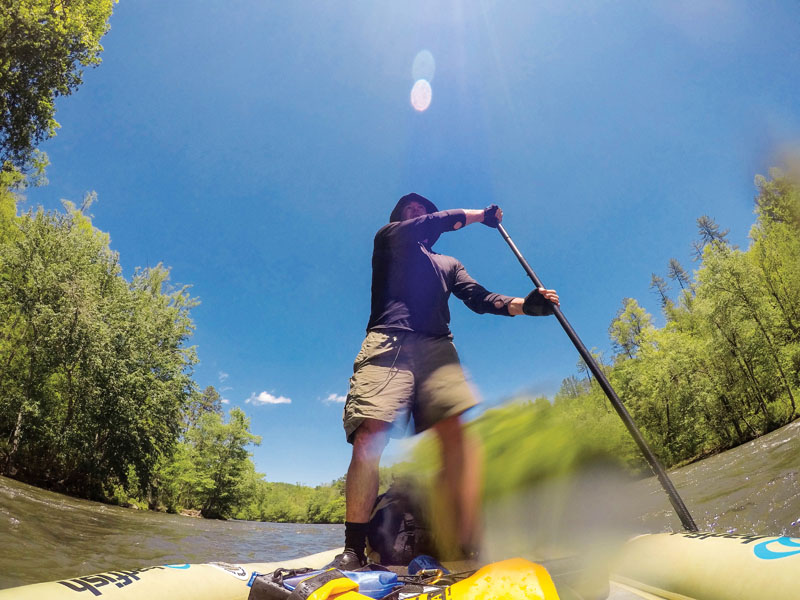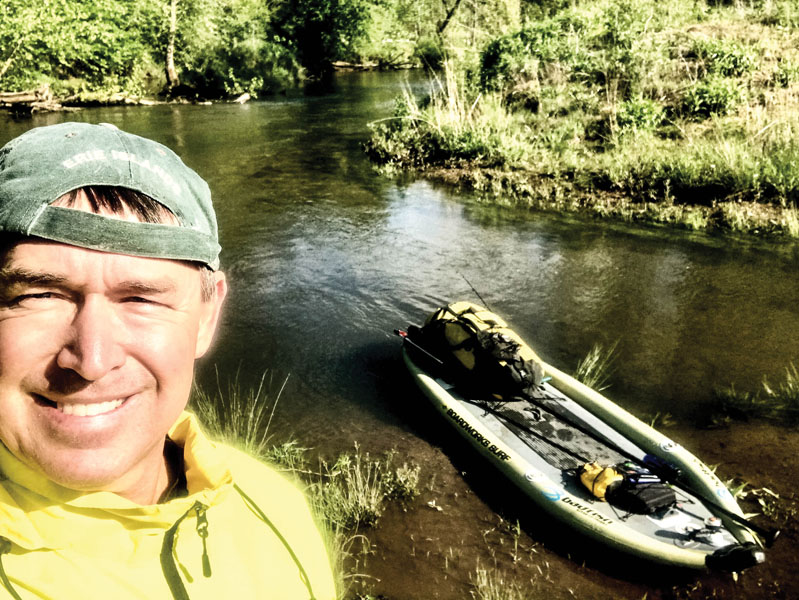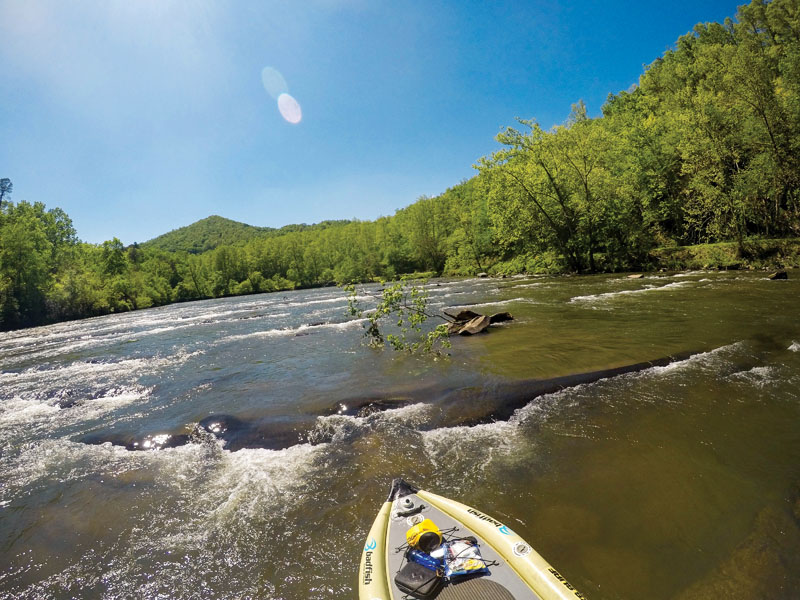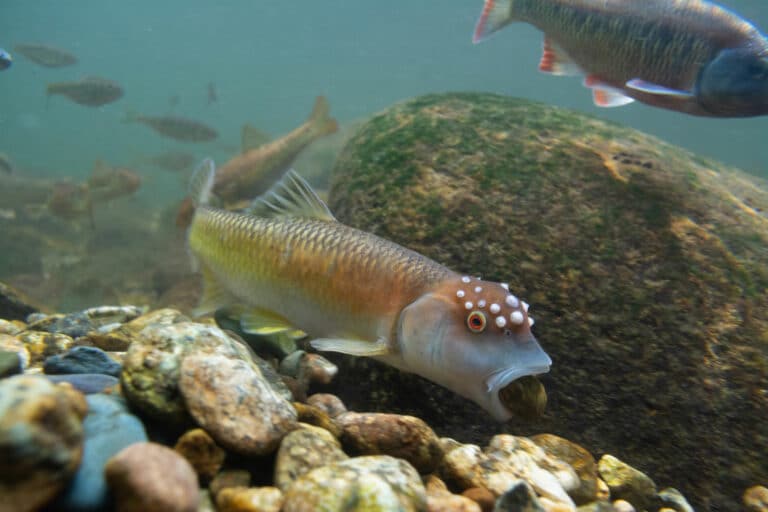Follow along as Paddleboarder Chris Lechner completes a SUP first descent of the 139-mile Little Tennessee River. Along the way, he uncovers history beneath the water and wisdom from unexpected sources.
Day 1
Rabun Gap, Ga.
The river begins as a small rivulet in the middle of a cattle farm in north Georgia. I crawl under barbed wire and steel mesh fences, like crawling through a war zone, for two miles. For most of the first day, I carry my paddleboard over downed trees, beaver dams, and vine entanglements. Finally, I pass under Highway 441 and the Little Tennessee River starts to look more like a river, as wide as a driveway with a few rapids. I move past old bridge pylons and soon feel the river returning to a native state. Weeds are interspersed with rhododendron and laurel. Osprey nest in the trees, and woodland ducks paddle with me. I finish the day battered and exhausted.
Day 2
Franklin, N.C.
Heavy rains fill the swollen river, affording me quick passage over downed trees. I meander through farmland that gradually gets wilder as feeder creeks come in—including the mighty Cullasaja entering from Highlands in the east. These often unrecognized feeder creeks determine the health or sickness of a river. Author Wilma Dykeman said it best: “How right that we should say a spring is fed by veins—tiny threads of water leading from many sources—and that we can destroy a spring by probing too deeply for its delicate feeders.”

Day 3
Lake Emory to Driftwood Island
The day is clear, the sky a deep blue, and the sun is rising across the river, which flows into the ever-widening mouth of Lake Emory ahead, becoming slow and shallow. A large muskrat scurries into a hole as I contemplate the pros and cons of this artificial impoundment.
Some argue that the lake acts like a giant filter, collecting sediment and allowing the free-flowing river below the dam to run free of toxins produced by upstream farms. But I find this argument to be weak and unsupported. Natural flowing rivers evolve complex systems for managing sediment and dispersing toxins gradually, using biologic filters and natural barriers. The advantage of the native approach is that sediment moves downstream, avoiding the stagnation and hypoxia of man-made reservoirs.
When rivers are dammed, trout are replaced by catfish and carp, and many fish species die out because of the lower oxygen levels and the loss of clean sandy bottoms to lay their eggs. Some species dwindle or become extinct because they can no longer migrate upstream. Given enough time, Lake Emory will fill in and become a swamp. This is straightforward physics.
I finish paddling the four miles of Lake Emory above the dam. As I approach the shore, I see a bloated deer carcass bobbing in the water. The native Cherokee find meaning in daily occurrences like this. Is this dead deer telling me something? I stop and help the county officer hook the carcass and pull it out of the river.
The Cherokee people believe the deer is an animal of great power and intuition, and they would have given its death a meaning. Around the communal fire, the elders may have said that the Deer had sacrificed himself because the Great River is no longer flowing and has become putrid and sick because of our selfishness. Even the Beaver knows that a dam is only for a time and must be pulled down and moved to let the water flow free and breath again.
Below the dam, there is no boundary between pasture and river. Cattle wander in and out of the river, and the stench of manure is heavy in the air. Black plastic from farmers’ fields are wrapped around tree branches and limbs along the river. For years to come, the microparticulate degradation of this plastic will kill and contaminate the subsurface food chain, including minnows, crayfish, nymphs, and other river insects. I feel sick and helpless.
I pass through a small riverside community with a long suspension bridge and spot a v-shaped stone fish weir near the ancient Cherokee town of Cowee. It sweeps me downstream into the center of the river where the fish nets would have once been placed.
I arrive at a small island at dusk. It is a good place to camp. In the twilight, the island’s heaped-up driftwood takes on gargoyle shapes and sinister postures. I nestle my paddleboard on the lee side of the island and snuggle and balance it between the driftwood. I string my tarp overhead to keep out the rain. I soon have a roaring fire flickering light and dancing shadows over my island home. I fall asleep to the drizzling of rain.
[nextpage title=”Read on!”]
Day 4
The Cherokee on the Riverbank
I awake to the honking of geese. The smell of woodsmoke swirls around my head. I am cocooned by the warmth of my sleeping bag. Insects hatch over the water in a milky white haze that hovers over the river. Fish swirl, birds dart, and the morning river sounds symphonic.
Before making coffee, I check the fishing pole. I feel a childlike joy as the rod tip bends and bobs with that unique fish rhythm. I reel in a steel gray catfish the length of my forearm. He is muscular and healthy, and I realize it is the sparkling river that highlights and beautifies him. This is breakfast. The morning sun has not yet broken as I take him to the other side of the island and find a flat rock. I pin him down, give thanks, and slice the filet knife just behind his sharp pectoral fin. I flip him over and quickly repeat a symmetric cut and then snap his spine. He shudders once and lies still on the bloody stone. I grab the rubbery skin with my pliers and pull it off in one swift motion. I throw the head and skin in the river and keep the entrails for cutbait. I place the two pink filets in a Ziploc bag filled with flour, salt, and pepper and shake it up. I soon have two sizzling catfish fillets frying over the open fire next to a pot of steaming black coffee.

I paddle off into the Needmore section, the last piece of native river before Lake Fontana. I remember a story I read about the naming of the little riverside town of Needmore. Early settlers in the 1820s were always traveling farther west down the Little Tennessee River to the nearby town of Almond. They would say “I need more milk” and other essentials, and soon the name Needmore stuck.
The Needmore section is wide and open and feels like a western river. The granite rock juts out of the riverbed obliquely, creating a series of rapids and a maze of channels to navigate. Sometimes I am forced to make tight hairpin turns to avoid shallow rocky shoals. This is the most challenging section of the river on a stand up paddleboard because of the swift water pouring over sharp hidden rocks. My rudder catches a few times, threatening to catapult me forward, but I manage to stay upright and dry. I have not fallen off the paddleboard.
Just before the last rapid, I see a Cherokee man standing on river right wearing a grizzly bear t-shirt and hand-crafted earrings. He waves, and I paddle through a maze of rocks to the sandy bank and introduce myself. He tells me his name is Dean Swimmer, and he is full blood Cherokee, descended from a famous medicine man and healer with the Cherokee Nation “many moons ago.”
“What brings you to the river today?” I ask.
“This is where I come to think,” he replies. I step on shore and tell him about my river trip. He smiles and walks me to the edge of the river. Then he bends down and pulls up a leafy plant ‘sochan’ and says, “Here, your body needs this.” As I chew on the natural lettuce, he points out some other edible plants and explains that the native Cherokee along this river relied heavily on plants for nutrition and medicine.
He turns and gives a blessing and a warning: “Everything you need to know can be learned from this river. A time will come when you feel like you are making no progress. The river may require something of you. The river is always teaching. Listen!”
I step on the paddleboard so overwhelmed by this encounter that I almost fall off in front of him. I feel sheepish and smile. He smiles back and I paddle off into the last stretch of whitewater.
Day 5
Lake Fontana
The first four hours of paddling across Lake Fontana are quiet and uneventful. I move around houseboats and notice areas of flotsam filled with garbage. Plastic bottles accumulate in tidal zones embedded in a thick brownish gray foam.
At 11am, a gusting wind blows suddenly from the west. I am still paddling my sluggish inflatable paddleboard, which was perfect for navigating the shoals and rapids but is now punishing me on this windy lake. Stroke by stroke, I pull against the wind, my body acting as a sail pushing the wrong direction. I am carrying an 80-pound pack which adds to my troubles. Waves over two feet high batter the bow, and I resort to tacking across the lake searching for refuge behind shoreline trees. I normally paddle at three miles per hour, but today I move at one mile per hour and I still have ten miles to go.
I settle in to this punishing routine and remember the words of my Cherokee friend, Dean Swimmer: “Sometimes you will feel like you are not making any progress.” I smile at his prophecy and remember my swimming mantra, “one stroke at a time.” I refuse to give in to the wicked wind of the west. My leather cycling gloves protect my palms but not my fingertips. I pull the T-grip of my paddle with such force that the skin splits on my left index and middle fingertip, making a bloody mess.
Gradually I let go of frustration and accept the gusting wind and pain. I notice details: the sound of water lapping against the bow, the shape of the water as it rises and falls, sunlight dancing like diamonds on the surface, sweet shoreline smells. Even the dull pain in my back and sharp pain in my fingertips becomes interesting and observable. I enter the zone, a place where time slips away and each moment becomes a thing unto itself, no longer tethered and encumbered by expectation.
The last 10 miles to the Fontana Dam are fairly straight, making the wind even more difficult, but I finish my marathon: 26 miles of flatwater paddling against a 15 knot wind.
I camp below the lights of Fontana Dam. The campground is a postage stamp of green sitting vulnerably at the bottom of a massive fortress of concrete. At night it hums and glows with a pulsating light that feeds my alien dreams. I awake early and climb down the embankment of artificial white boulders to a river that looks fake as it pours out of the concrete.
It saddens me to realize the Little Tennessee River has been sacrificed for this dam. I remind myself it generates 238.5 megawatts of clean energy. I leave the darkness with renewed determination to search for remnants of the original river.
The native Cherokee were driven out of this valley and impounded in Oklahoma in 1838. The native Little Tennessee river was dammed and impounded in 1944. Two thirds of the original Little Tennessee River was seized and enclosed. All rivers were once native and wild. This river existed long before white settlers came to America. The building of dams mark our effort to harness the energy found in nature. It may be time to evaluate the long term ecological consequences.
The next 26 miles of river cuts through a steep gorge from east to west and then opens up into a wide valley near Lenoir City, Tennessee. This river valley was home to the Overhill Cherokee and included many important towns like Citico, Tallassee, Tanasi, and Chota. High granite walls enclose the valley, and the Little Tennessee River once flowed in the center filled with native trout and wildlife. The Cherokee enjoyed the protection afforded by such isolation.
The height and narrowness of the granite walls also make it ideal for harnessing energy. The Cheoah Dam was built in 1919 followed by the Calderwood Dam in 1930 and the Chilhowee Dam in 1957. These dams are spaced approximately 8-10 miles apart and generate significant energy because of the physics afforded by the steep gorge.
Native and nonnative trout species thrive in these cold waters. The turquoise green water merges with the green mountain laurel and rhododendron along the banks and the blue sky above. This is punctuated by wildflowers, white and pink laurel blossoms and white clouds floating in the sky and reflected in the water. It feels like I am paddling in a kaleidoscope.
Eagles nest in the trees above and swoop down on fish swirling at the surface. The isolation of this place is awe-inspiring. I peer into the depths and see occasional clean-cut tree stumps—ghost-like remnants of the original river. I remind myself of the Cherokee villages and burial sites directly beneath my paddleboard. My silent reflections are broken by the cry of an eagle.
Day 7
No Trespassing
The Chilhowee Dam is owned and operated by a private company. In September of 2015 they closed the dam for repairs. It is still not open almost two years later. They drained the reservoir back to the original level of the Little Tennessee River, exposing buried bridges, roads and ancient Cherokee settlements.
I was fascinated and excited about this opportunity to paddle native river that had not been seen since the dam was built in 1957. But the company repeatedly refused my letters, emails, and requests to paddle this 10-mile stretch.
I considered paddling or swimming it anyway, but then I remember what Dean Swimmer said just a few days ago: “Listen to the River.” And what I heard it saying to me was this: “You honor the Cherokee people by staying off the reservoir and the exposed sacred lands. You honor the private company by doing the same.”
Day 8
Tellico
I replace my inflatable paddleboard with a sleek catamaran style paddleboard and start the 33 mile crossing of Lake Tellico. The river widens grotesquely into a large muddy bayou. How did it change from turquoise blue to muddy brown in the equivalent of a city block? The water looks like a chocolate milkshake, and black torpedo shapes are lined up in groups just under the surface. Carp as big as small alligators feed in the weeds.
I catch a catfish, but then I consider the lake. There are five main chemicals that contaminate Lake Tellico: PCBs, chlordane, DDT, dioxin, and mercury. Recommendations from the Tennessee Valley Authority are to eat smaller and younger fish, discard skin and fatty parts, and avoid bottom dwelling fish. This large catfish fails the test and gets released.
Later that night, camped on the banks of the lake, I awaken, startled by growling and snapping just behind my tarp. I quietly duct tape my filet knife to the end of my 8 foot paddle and turn my headlight toward the growling: five shaggy coyotes turn toward me and freeze. They start whining and then turn and run. I pack up camp in record time. As I step on my paddleboard, a six foot black snake slithers beneath my feet. It is 3am. I paddle about 12 miles in the dark.
Day 11
Echoes of the Past
On my final morning, I explore partially exposed farm silos flooded by the lake. I put on my bathing suit and goggles and dive down to the base. I feel around in the mud and come up with two pieces of wood. I clean off the mud and notice streaks of red barn paint. I keep these artifacts to remember this journey.
I return to the water and dive down through a small hole at the base of the silo and come up inside. It is dark with a halo of milky white sunlight at the top. It echoes with the past as I slowly climb the narrow rebar ladder. I check each rusted rung carefully before giving it my full weight. I reach the top a little shaky and look out across the lake at a string of orderly mansions and manicured lawns. I imagine a different scene 40 years ago when a small river wound gently through a pastoral valley. I climb down and paddle around the corner to see the Tellico Dam for the first time.
The structure is surprisingly small in proportion to the area of land it flooded. It is inconspicuously tucked off to the left side of the lake. I float several feet from the dam and peer cautiously over the metal release gate at the Tennessee River far below.
The Little Tennessee River is referred to by some as the ugly stepsister to the more pristine Tuckaseegee and Nantahala Rivers. Even their names are more beautiful, rich in Cherokee history. Tuckaseegee means “place of the turtle,” and Nantahala means “land of the noonday sun.” What does Little Tennessee mean? Dean Swimmer taught me that Kituwa is the true name of his people and it means “people of the deer clan.” I will remember his ancestral river home fondly, not as the Little Tennessee River but as the Kituwa River, “river of the deer clan.”








